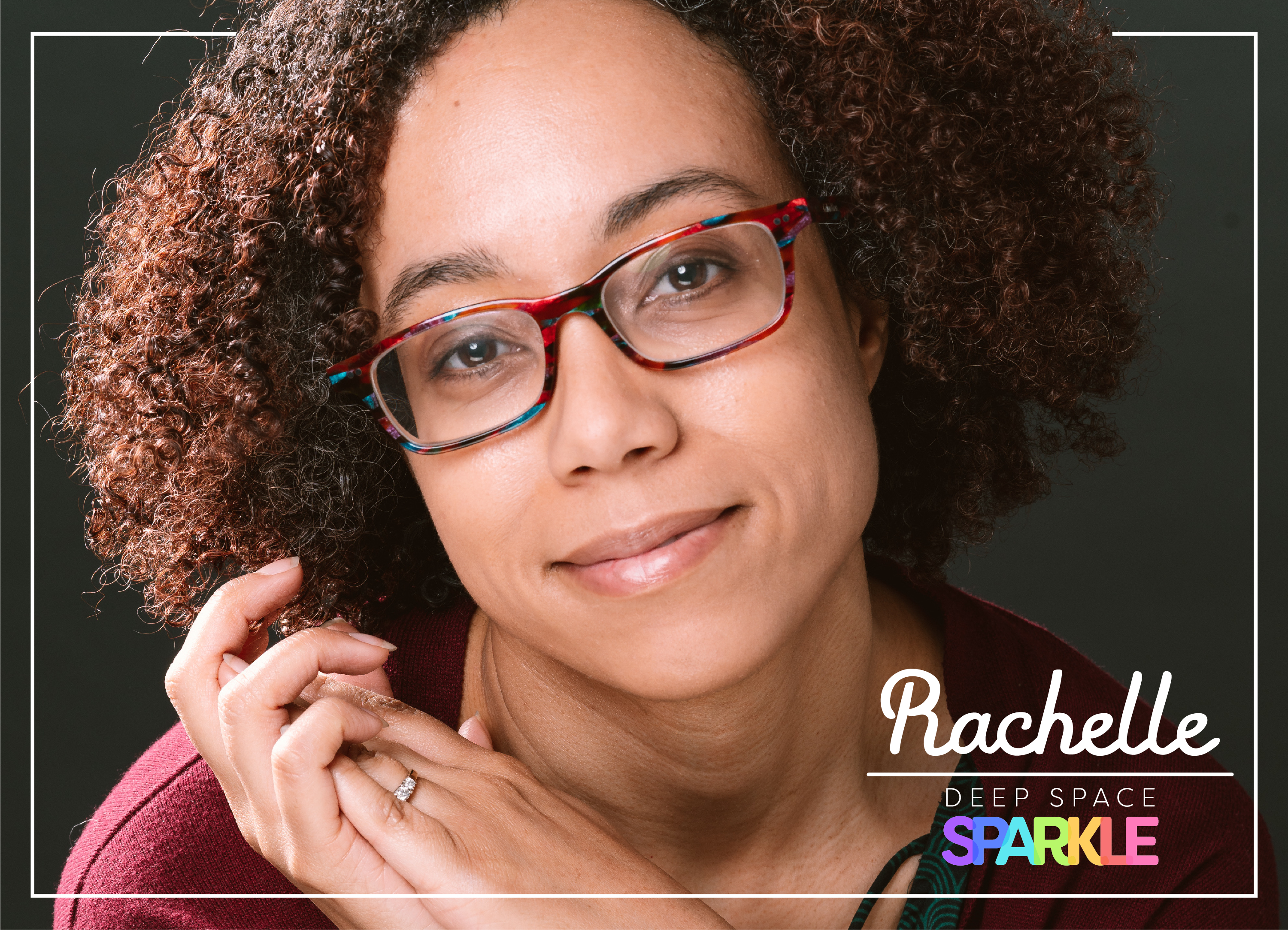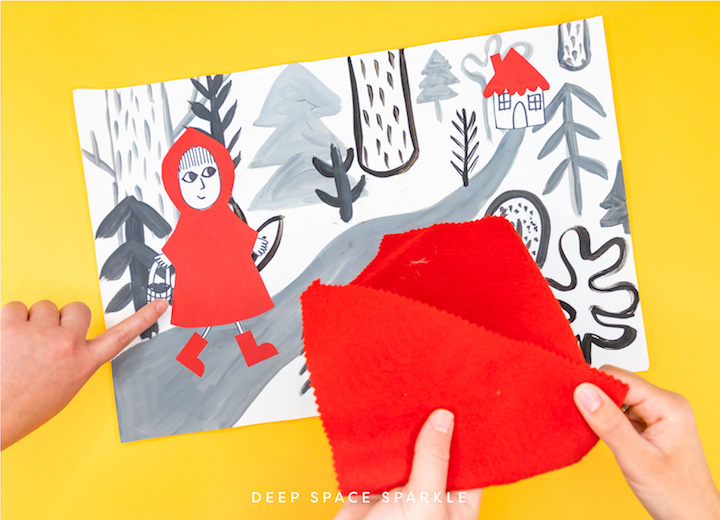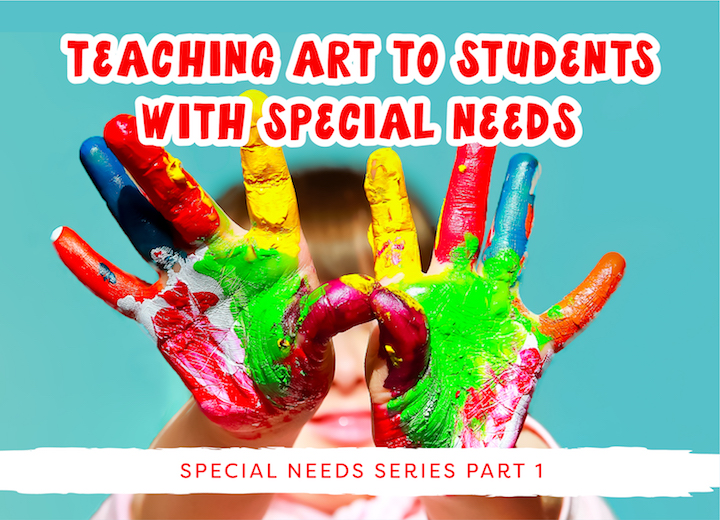That’s not going to work for our kids.
Those are the words a special education teacher said to me on my first day of working as an art teacher at a specialized school for children with disabilities.
I was devastated.
I had spent so much time planning and envisioning what the school year would look like for my students, but the bottom line was, I didn’t know the children.
I had to quickly pivot and change up my whole teaching plan.
Before I go any further, let me introduce myself. I’m Rachelle and the newest member to Team Sparkle. I teach art exclusively to children with special needs. I work with children who have mild to severe developmental disabilities, children who have autism, children who are blind, deaf, and deaf-blind, children who have cerebral palsy and children with multiple disabilities. I also work with children who have mild intellectual disabilities.

And just like you, I’m a teacher who is always learning and growing to better serve my students.
Over the next 3 days, I’ll share with you my ups and downs, and tips and strategies for teaching art to children with special needs. I’ve put together a resource guide that pairs with the final installment of the series that will provide you with a way to access all the helpful information you need at your fingertips (scroll to the bottom to download this PDF).
So, back to my first day of teaching…
I decided to allow myself to be open and flexible for the first few weeks of school, so that I could learn from my students about how they wanted to be taught. Instead of coming in with all of my ideas and plans for how I was going to teach, I needed to allow for some time to really get to know my students first.
Because of that simple change of mindset, I had an amazing school year.
Don’t get me wrong. It wasn’t perfect, and I made my fair share of mistakes, but I used those mistakes as learning opportunities to grow and improve as an art teacher.
If I would have stuck to my original plan and not taken the feedback of my colleague seriously, I would have missed out on an opportunity to really connect with my students. Instead, I chose to use that teacher’s feedback to design an art curriculum that was child-centered and built upon the strengths that my students already had.
The teachers and teacher aides commented that year about how much they enjoyed being in my art class. Some of them didn’t even want to leave when the bell rang. It was heartwarming to get such a positive response to my teaching. I was happy that I had created a welcoming and safe classroom environment for everyone who stepped inside.

Some of the teachers shared with me that the previous art teacher had not been so welcoming. How she hadn’t let the children touch any of the examples she brought to the classroom, or how she would shove paint brushes into the children’s hands. These simple actions upset them so much that they would end up throwing the paintbrushes across the room. Art wasn’t enjoyable at all and the children actually dreaded it to the point where they stopped going altogether.
That’s not what I want for my students and it’s not what I want for you.
It saddened me to learn that students with special needs miss out on art simply because we aren’t willing to listen, learn and adapt.
I thought about how that art teacher could have been me.
If I hadn’t been willing to change things up and learn about my students, I may have created an unwelcoming environment where my students didn’t feel comfortable enough to enjoy art.
I’m so grateful that things turned out differently for me. I have enjoyed getting to know my students with disabilities. I continue to learn from them and adapt and modify my art curriculum, so that it is customized to meeting each child’s individual needs.

I think back to that first day of school and I’m thankful that I decided to listen to the wisdom of what that teacher was telling me. Because of her words and my willingness to listen and pivot, I was able to create a learning environment and design an art curriculum that supported every child in experiencing the joy of making art.
And that’s what I want for you! Check out my next installment on Teaching Art Remotely to Students with Special Needs: Part II where I will be sharing how to teach students with special needs remotely. And following my final installment on Modifying Art Lessons to Meet the Needs of Special Learners: Part III.
Click the button below to download my resource guide that includes virtual teaching tips, a sample lesson structure, adaptive art materials and book recommendations:

Have any questions? Please write any of your comments or questions in the comment section below.














Thank you .Thank you .Thank you. I am and have taught students with special needs. How do you teach art to students on the autism spectrum? The problem isthere are so many spectrum. How do you teach art to a kid that has sid..? I taught this student with sid in a regular class but was told art might be harder to adapt to.
Hi Leanie! Thank you for your questions! I have several students who are on the spectrum, and each one is very different. By “Sid” are you referring to severe intellectual disability? There are many acronyms out there and it seems that different ones are used in different parts of the country and world. For children who have severe intellectual disabilities, I make sure to breakdown the lesson into very manageable parts, and I spend more time on each stage. Let me know if you have more questions. You can always reach out to me inside the Sparklers Club Facebook Group.
Im welling to learn more about it this is what I wanted to do.
As a special educator and a parent of a child with severe multiple disabilities, including no purposeful hand use, this is a subject very near my heart. Our kids NEED to create! Yet so often the projects my daughter brought home were completed by her paraeducator or done hand-over-hand. There are so many ways to adapt regular classroom lessons for inclusion of kids with even really challenging physical disabilities or to create group lessons that foster independent creation.
What our young artists and their families value is the highest participation possible–not a pretty polished product. Give me a smeared paint splatters on a Mother’s Day card — created independently — over one with a row of adorable flowers painted by an adult helper any day!
Thank you so much for this series…I’m eager to read the additional articles.
Thank you so much for this!!!!i seriously wish I would have found this sooner because I have struggled SO much with virtual learning with m students!! I am an art teacher at an all special needs private school where most of my kids have VERY limited mobility and/or motor skills. I’ve been teaching online since March and it is SO hard for these guys. I have found ways to make it sort of work but most result in parents doing for them or staff doing for them (some students live there) and it’s so frustrating. I hear “they can’t do that” all the time and it makes me so sad because THEY CAN! I just started this job in November and man I got the kids to do things their paras would say they can’t. I spent my whole class jumping kid to kid and doing the projects with them so the aids wouldn’t do it FOR them. I cannot wait to go back to school when it’s safe so I can be there for these guys and keep proving they CAN. I try to remind paras all the time “ it’s all about process” and they don’t get it. They continue to change a kids work so it looks perfect and to me, it was perfect when it was the child’s. Even if it was a mess or a blob <3
I have a rule to never touch a students art work. I tell them this up front and they are usually thrilled. If they have a question about how to do something, I sit down next to them with my own paper to demonstrate. Everyone enjoys a project that they have done. My child threw away art this year that the teacher had marked on saying it was no longer hers.
“SID” may also mean Sensory Integration Disorder
Thank you do much for posting.
Thank you Rachelle and Sparkler Team! I appreciate having the insight of a special education art teacher very much. At my site all our SDC students are fully included for art lessons and making adaptations for your projects is incredibly helpful. I really liked your material substitutions, and para educator tip sheet. I’m struggling a bit with modifications while we are are fully remote. I am thinking now of sending home some alternate supplies. Thank you for your work in this area bringing art to everyone!
great!!!
Hi! I really love what you do and what you share. Could you share how you ended up at that job, what made you choose it, and what your educational background was? I would love to hear so I can understand how to better prepare my self to go into this field
Hi Alanna,
You can read about Patty’s story here: https://www.deepspacesparkle.com/patty-palmer-3/
-Team Sparkle
Hi Rachel I am interested to know more about your preparation for teaching the special.beed children …how would the lesson plan be and what goals to achieve .
I am proposing a curriculum.for a Special.Need School here in my area where I live . I used to have my own art centre and have special need children one to one based . But now I have like the whole school to teach…kindly assist me with a few tips .
Hello,
I am new to this resource and new adaptive art teaching. The link to the resource is guide is not working. Is this site still receiving updates and usage? Am I doing some incorrect, is further action on my part needed for access? Thank you and I have enjoyed what I have been able to t discover here.
– Kenny
Hi Kenny! Thanks so much for letting us know about the issue with out link. We have fixed the link and if you click the box and add your email we will send this directly to your inbox. Enjoy.
Can you please share what qualifications you need to get into this field. Thank you.
Hello Rachelle,
do you have any ideas or tips for teaching art to adults with intellectual difficulties? I like to try and make the instruction person centered and also age appropriate, so the students doesn’t feel patronized in anyway.
My name is Monique Pope I worked with special needs clients we are looking for someone to come in to our program to teach the clients and staff art if you can help let me know .The name of the program is The pines Adult day Center.
WE NEED AN ART TEACHER HERE IN POCAHONTAS ARKANSAS FOR DISANLED KIDS AND ADULTS THERES NOTHING HERE FOR THEM SO I AM BEING THEIR VOICE PLEASE CAN YOU HELP?
Hi Rachelle.
My school is hosting a professional development day for art, music and PE and the focus is – Making meaningful modifications for students with special needs. Would you be interested in presenting? It is March of 2024. We are located in Akron, OH so if you are in Columbus that would not be too far. Thank you!
Hi Rachelle, this is a heartwarming story. However the lack of any detail/examples about either your students, teaching approach, or actual “curriculum” makes it pretty much useless for another teacher to use.
Hi Robert! Did you see this is the first of a 3 part series? Check out her next installment on Teaching Art Remotely to Students with Special Needs: Part II where she is sharing how to teach students with special needs remotely. And fher final installment on Modifying Art Lessons to Meet the Needs of Special Learners: Part III. There are plenty of details, tips, suggestions to help any teacher.
You can also click to download a resource guide that includes virtual teaching tips, a sample lesson structure, adaptive art materials and book recommendations. Lots of useful information included in all of the above.
I loved this thoughtful post on encouraging creativity in children through art. The practical tips and interesting examples you shared highlight the importance of promoting artistic expression in young minds. As an educator, I found your approach both inspiring and accessible, making it easier to incorporate these ideas into the classroom. Thank you for sharing such valuable resources.
Do y have a in person class around Decatur alabama! For art classes
Hi Ann! We don’t host any in person classes. We are an online company that provides lessons and curriculum to Art Teachers. We wish you the best of luck with finding an in person class near you.
I’m not a teacher..I do art..not a fabulous artist…but at church and the place I volunteer…God seems to be placing special needs kids in my path.thinkig of what I need to do to learn how to do art with special needs kids…or whomever..even one by one…any ideas thank you Glenda price
Hi, I am not a qualified art teacher with degrees, I am a self taught artist. I do paint classes where they trace and paint. I have been asked to teach art to 5 or 6 children with disabilities. I am a 70 year old grandma with two of the kids my grandchildren. Help!
Hi Georgina! We’re so happy you found us. The Sparklers’ Club is an affordable and flexible pay as you go monthly membership—perfect for anyone who teaches art to students aged K-7. To join the Sparklers’ Club waitlist and learn more about The Sparklers’ Club click here: https://deepspacesparkle.lpages.co/the-sparklers-club-waitlist/. We offer lots of resources for anyone teaching art to children with disabilities and we are trying to expand on those resources all the time. Email us at support@deepspacesparkle.com with questions.
We need a in home art teacher, or individual learning for my 16 years old daughter.
How to teach special needs child
Hey my name is Tonita Williams,I when to college for fashion designer LEHIGH valley college,I love art I love doing art and crafts,my son have ADDH and love when we did art and crafts, I also have learning Disabilitie I want them to no u can do it ,If u see me you can’t tell, Im 37 mother of 2 growing boys,A 16 teen year old,and 14 year old. Thank you!!!